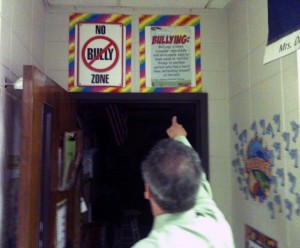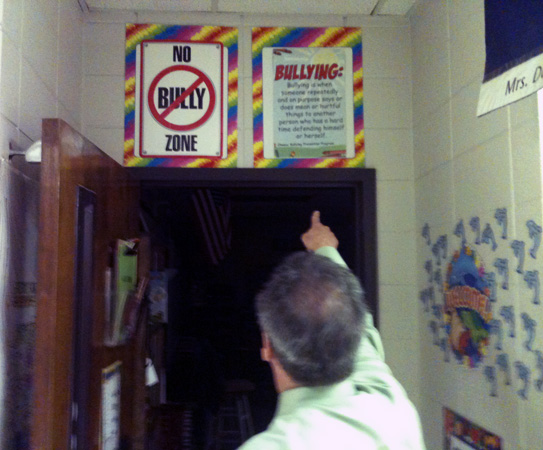LISTEN:

Prevention and intervention counselor Jeff Dess points to anti-bullying posters displayed at Mt. Bethel Elementary School.
Public school students and parents are seeing some changes this year in the way their schools handle bullying. That’s because of a law passed by the state Legislature last year that schools are now starting to put into practice.
In a four-part series, the Southern Education Desk and the Juvenile Justice Information Exchange are examining the new law and its impact on students, families and schools.
The state education department’s Garry McGiboney has been helping Georgia’s schools stop bullies since the early 1990s. But since the state Legislature passed the revamped bullying law last year, McGiboney says he’s seen a change.
“Our view has come from responding to questions and responding to requests for training, which has been unlike anything I’ve ever seen in my career as an educator,” McGiboney says. “There’s more attention inGeorgiaon bullying prevention right now than anything I’ve ever heard about.”
McGiboney has kept busy, training teachers, administrators -- even school bus drivers. Every adult who works in a school is now legally mandated to report bullying if he or she sees it. So educators want to make sure that they know how to spot the behavior -- and how they should respond when they do.
But McGiboney says there’s been a shift in the types of questions educators ask since the law was passed. At first, he got mainly operational questions about how to put the law into practice.
“But that has changed from questions about the law more to questions and an interest in bullying prevention and bullying intervention,” he says.
The reasoning is that it’s better to stop mean teasing and harassment before it builds enough to reach the legal standard for bullying.
So how do you stop bullying? How do you even recognize bullying? Three students at Mt.Bethel Elementary School in Marietta, just north of Atlanta, gave three different answers, each touching on elements of what researchers and educators accept as a formal definition of bullying.
– “A bully is probably like the meanest person. That’s what comes to my mind, like someone pushing someone.”
– “Like when they push you or shove you. Bullying is like, when something is unfair and one-sided, it happens when people are usually upset about something and they go after you and they take it all out on people.”
– “I’ve seen someone getting bullied, but I told a teacher.”
Jeff Dess’ job is to help schools make sure students like these know the best answer to those questions. Dess runs a prevention and intervention program in Cobb County that experts point to as a model for bullying prevention done right.
Dess has come to Mt. Bethel to work with the school’s “bullying committee.” It’s a group of teachers and administrators -- led by guidance counselor Kellie Oakes – charged with developing the school’s bullying prevention strategies.
School has just let out for the day, and as she and Dess wait for the teachers on the committee to assemble, Oakes explains that they have volunteered for the job. It’s not a huge commitment, she says, but it does require the staff to commit to something extra. She pages the main office to ask for them to make an announcement reminding staff about the meeting.
“Bully them to come!” Dess jokes.
When it convenes, the committee launches into a discussion of how best to integrate their prevention strategies into the classroom. Dess throws out a number of options:
– Should they repeat last year’s contest, which challenged each classroom to create a poster illustrating positive behaviors?
– Should they keep last year’s winning poster and hold a different activity this year in which students in each grade illustrate character words like caring, kindness and empathy?
– Or, should they follow the lead of another school and have fifth graders produce videos demonstrating the difference between tattling on someone and telling an adult about behavior that could hurt someone?
They also go over a survey that the counselors plan to give to the school’s older students. Dess explains one change this year that will, for the first time, let the school track instances of bullying over time.
Dess reads the new question aloud: “I was bullied in the past 30 days in the following ways: physical -- pushing shoving tripping hitting; verbal -- hurtful teasing insults making threats; cyber -- computer or texts; left out or ignored on purpose. And their choices are not at all, 1-3, 4-5.”
“This will give you a direct indicator of whether bullying is going up or down and in which areas it’s going up or down,” Dess tells the committee.
Peggy Haag teaches second grade at Mt Bethel and is a volunteer on the bullying committee. She says that even before the law, prevention work has helped the students learn to check themselves against bullying.
“I think children are more aware of the fact that that’s called bullying and that ‘I better be careful of what I do and that there are consequences for it,’” Haag says.
The results of a survey that theMt.Bethel counselors gave to students last year seem to bear that out -- but also suggest challenges. Around 85 percent of last year’s third through fifth graders said they would report bullying if they saw it. But if they saw someone being ganged up on by a group, the number of students who said they’d report it dropped to 68 percent.
Oakes says there was some nervousness at the school when they began to implement the full documentation required by the new law. It seemed overwhelming.
“It was such a grey area, really,” Oakes says. “We were like, ‘what about this?’ Teachers are going to feel like they have to write down if somebody looked at somebody. We were afraid that people were going to be feeling like they had to fill them out all the time.”
But Oakes says the paperwork has been manageable. She also says the law has helped change the way she communicates with parents, for the better.
“Before, maybe we would have just talked to a kid about an incident, kind of kept it in mind, but we weren’t maybe contacting the parent every time,” Oakes says. “But now -- I had a couple yesterday, where I just wrote it up -- ‘you know, it’s not bullying yet but we have to keep an eye on it.’ And both parents were right on top of it. It prepares them too, so they’re not so surprised.”
But the process of spreading bullying prevention efforts around a school does take a lot of work. In an ideal world, Dess says that he would take a full day and a half to train teachers and staff on bullying prevention strategies.
But in the real world, Dess says he’s lucky if he can get 45 minutes of teachers’ time in a faculty meeting.
And then there’s the question of funding. Federal funding that has supported Dess’ program ran out this month, and Dess and the program’s other administrators aren’t sure if they’ll be able to find the money to fill the gap.
Read more about the work Jeff Dess and other prevention and intervention counselors are doing to stop bullying here.

witnesses are the key to stopping bulying
you just gotta give them the way to report in anonymously and they will
nobody wants to be “the snitch”